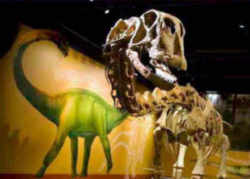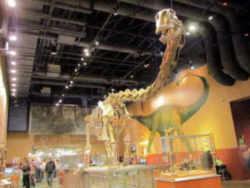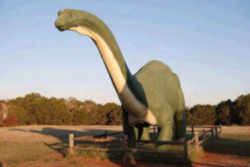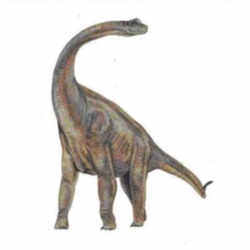
Texas Symbols
Texas State Dinosaur
Quadrupedal Sauropod

(Paluxysaurus jonesi)
Adopted on June 19, 2009.
Quadrupedal Sauropod, (Paluxysaurus jonesi,) replaced Sauropod dinosaur,(Pleurocoelus,) as the official lone star state dinosaur when Governor Rick Perry signed House Concurrent Resolution No. 16 on June 19, 2009.
Pleurocoeus reigned for seven years before being dethroned by the work of a Southern Methodist University graduate student.
The fossilized bones thought to be Pleurocoelus were identified, instead, as a new species by SMU graduate student Peter Rose. The new species, Paluxysaurus jonesi, was named by Rose for the the town of Paluxy and the Paluxy River and the Jones Ranch where the fossils were discovered.
Backed by the Fort Worth Museum of Science and History, the erroneous promotion of Pleurocoelus as the official lone star state dinosaur
was put on the road to correction by the introduction of House Concurrent Resolution No. 16 on February 18, 2009.
The resolution, introduced by State Representative Charles Geren, declared that an error had been made and that this resolution would correct that
error.
The fossilized bones that were thought to be Pleurocoelus have been properly identified as a new species named Paluxysaurus jonesi; the identification was made by Peter Rose during his graduate studies at Southern Methodist University, and his findings have been widely accepted by other scientists since being published in 2007" ("Texas Legislature Online")
Texas State Fossil: Quadrupedal Sauropod

Sauroposeidon (meaning "earthquake god lizard", after the Greek god Poseidon) is a genus of sauropod dinosaur known from several incomplete specimens including a bone bed and fossilized trackways that have been found in the American states of Oklahoma, Wyoming, and Texas. The fossils were found in rocks dating from near the end of the Early Cretaceous (Aptian-early Albian), a time when sauropod diversity in North America had greatly diminished. It was the last known North American sauropod prior to an absence of the group on the continent of roughly 40 million years that ended with the appearance of Alamosaurus during the Maastrichtian.
While the holotype remains were initially discovered in 1994, due to their unexpected age and unusual size they were initially misclassified as pieces of petrified wood. A more detailed analysis in 1999 revealed their true nature which resulted in a minor media frenzy, and formal publication of the find the following year.
While initially described as a brachiosaurid closely related to Brachiosaurus and Giraffatitan, the discovery of additional remains in the Cloverly Formation of Wyoming suggested that it was in fact more closely related to the titanosaurs, in the group Somphospondyli. Analysis of these remains and comparison with others from Texas supported this conclusion, and demonstrated that the more completely known sauropods from the Twin Mountains Formation (including a partial skull and fossil trackways) previously named Paluxysaurus jonesi also belonged to Sauroposeidon
Characteristics of the Quadrupedal Sauropod (Paluxysaurus jonesi)

The Early Cretaceous sauropod Paluxysaurus jonesi weighed 20 tons, was 60 feet long and had a neck 26 feet long, according to the scientists who have prepared the world's first full skeletal mount of the dinosaur.
The massive Paluxysaurus jonesi, prepared for the Fort Worth Museum of Science and History in Fort Worth, was unveiled Nov. 20 2009 when the museum opened in a new $80 million facility. The Paluxysaurus mount enables Texans to see their state dinosaur in three dimensions for the first time.
A relative of Brachiosaurus and Camarasaurus, Paluxysaurus lived about 110 million to 115 million years ago. The dinosaur was identified and named in 2007 by Peter J. Rose. The Fort Worth skeleton was assembled from a combination of actual fossil bones from at least four different dinosaurs found on private ranch land in North Central Texas and from cast lightweight foam pieces modeled on original bones. The mount enables scientists to better understand the animal's anatomy, size and stature on questions like "How were the legs situated, and how did the shoulders relate to the hips?"

From the skeletal mount, the scientists learned that Paluxysaurus was more than 6 feet wide and nearly 12 feet tall at the shoulder, although built fairly light, Winkler says. Its teeth are a lot slimmer than those of its closest relatives, indicating Paluxysaurus gathered and processed food differently, using its teeth not for chewing, but to grab food, he says.
Paluxysaurus had a long neck like Brachiosaurus, and a tail almost as long, but wasn't quite so gigantic. Scientists also learned Paluxysaurus had relatively long front arms, unlike Diplodocus, making its back more level. The dinosaur's shoulder turned out fairly high, and the hips were wide, Winkler says, and it had reached a more advanced stage of evolution than Late Jurassic sauropods.
Paluxysaurus' massive pelvis and its sacrum have never before been viewed by the public, he says. Its ilium, the largest bone in the pelvis, is similar to that of titanosaurids of the Late Cretaceous, mainly found in South America. However, one titanosaurid, called Alamosaurus, entered North America and is known from Big Bend National Park in southwest Texas.
The bones assembled for Fort Worth's Paluxysaurus mount were recovered by students, faculty, staff and hundreds of volunteers over the past 16 years.
Texas Senate Concurrent Resolution No. 57
In 1997 the Brachiosaur Sauropod, Pleurocoelus, became the official Lone Star State Dinosaur when Governor George W. Bush signed Senate Councurrent Resolution No. 57 on June 3, 1997.
S.C.R. No. 57
SENATE CONCURRENT RESOLUTION
WHEREAS, Texas has become world famous for its many dinosaur discoveries and for many of its unique dinosaur specimens such as the Pleurocoelus; and
WHEREAS, When the sea submerged the Antlers and the Paluxy formations, it put an end to dinosaurs in this region of the earth known as Texas for nearly
five million years, approximately 105 to 100 million years ago; and
WHEREAS, There was an interruption in North America's geographic history caused by the expansion of the sea 100 million years ago, creating the Western
Interior Sea Way which joined the Gulf of Mexico with the Arctic Ocean, thereby essentially splitting North America into two halves and remaining that
way until very near the end of the Age of Dinosaurs, about 66 million years ago; and
WHEREAS, Several formations were laid down in Central Texas during that interval of marine time, fossilizing the remains of the 65 to 70 foot creature
known as Pleurocoelus; and
WHEREAS, Today the footprints of Pleurocoelus created so long ago are visible once more, as featured in the Fort Worth Museum of Science and History's
exhibition, Lone Star Dinosaurs; and
WHEREAS, Sauropods, specifically the species Pleurocoelus, inhabited the earth approximately 65 to 200 million years ago, then died out, leaving the
footprints and bones in rock as young as 105 million years old, preserving this creature's prevalence in and across the State of Texas, causing the
trackway left in Glen Rose, and making this site world famous; and
WHEREAS, All Pleurocoelus disappeared from North America for 35 to 40 million years, then reappeared, returning to what is referred to as the second
dinosaur world in the heart of Texas; and
WHEREAS, Brachiosaur tracks are clearly the footprints of the species Pleurocoelus, large Quadrupedal Sauropod; they are responsible for not only the
tracks in the Glen Rose region but those scattered across Texas; and
WHEREAS, Because the Pleurocoelus tracks and bone are found mainly in Texas and a small portion of Southeastern New Mexico, this species and its remains
are the last major grouping of the Pleurocoelus, are indigenous to Texas, and are world famous; and
WHEREAS, The important locality referred to as the Jones site excavation of the Pleurocoelus is the biggest dinosaur project undertaken in the State
of Texas led by the Fort Worth Museum of Science and History; and
WHEREAS, These discoveries combined with the leadership of the Fort Worth Museum of Science and History in the field of dinosaur research make the
Pleurocoelus an ideal candidate to be the Lone Star State Dinosaur; now, therefore, be it
RESOLVED, That the 75th Legislature of the State of Texas hereby name the Brachiosaur Sauropod, Pleurocoelus, the official Lone Star State Dinosaur.
Texas Law
Paluxysaurus jonesi was designated the official lone star state dinosaur by House Concurrent Resolution 57 and is, therefore,
not listed in the Texas Statutes.
Only a small number of Texas' myriad symbols have been actually adopted by an act of the legislature and written into the Texas Statutes.
Taxonomic Hierarchy: Quadrupedal Sauropod
Kingdom: AnimaliaPhylum: Chordata
Order: Saurischia
Suborder: †Sauropodomorpha
Clade: †Titanosauriformes
Clade: †Somphospondyli
Genus: †Sauroposeidon Wedel, Cifelli & Sanders, 2000
Species: † S. proteles
Binomial name: Sauroposeidon proteles Wedel, Cifelli & Sanders, 2000
Synonyms: Paluxysaurus jonesi Rose, 2007

Some states that lack a "state fossil" have nevertheless singled out a fossil for formal designation such as a state dinosaur, rock, gem or stone.






